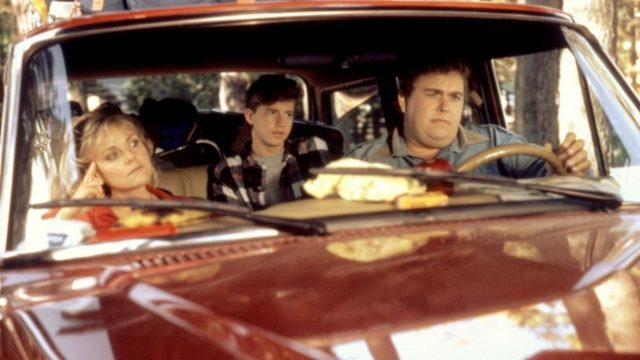This Week We’re Taking the Scenic Route to:
- John Candy
- imaginary friends
- forgotten sitcoms
- definitive works
- vinegar syndrome!
Thanks to Ruck Cohlchez and scb0212 for contributing this week. Send articles throughout the next week to ploughmanplods [at] gmail, post articles from the past week below for discussion, and Have a Happy Friday!
Jason Diamon of The Melt praises the Midwest Summer simplicity of The Great Outdoors:
The point of this is when you strip away the story of John Candy’s Chet trying to spend a peaceful summer in a cabin with his immediate family, only to have it ruined by his brother-in-law, Roman Craig (Dan Aykroyd), one of the all-time great yuppie dicks in cinematic history, you get a lot to appreciate. The film was shot at Ducey’s Bass Lake Lodge in California, but I had to wait until the Internet came along to find that out. I just figured it was some eastern Wisconsin lake town, the sort I find myself missing when it’s a warm Friday night and the Germans renting the apartment above me are partying for 48 hours straight. Sure, The Great Outdoors is a comedy filled with Chet crushing a massive steak (the Old 96er) and an angry bear with its ass hair blown off, but it’s also quaint.
At Episodes, Emily St. James relitigates and celebrates the brutal death of Bing Bong:
Every time I rewatch Inside Out, I expect the Bing Bong moment to hit me harder than it has before – especially now that I’m a parent – and every time, I still find myself thinking, “That was it?” Some of that is the almost programmatic nature of Bing Bong’s sacrifice. The second Joy says she’ll make sure Riley remembers Bing Bong, you know that fucking elephant-cat-dolphin is doomed. Yet the Up montage is similarly obvious in how it’s going to jerk every one of your tears, and I don’t bristle at that. It’s necessary for that movie to work in a way Bing Bong just isn’t. You could make a version of Inside Out that is roughly the same as the one we have without Bing Bong, and it would be just as good. It might even be better! Up without the opening montage is unquestionably a weaker film.
For Cracked, Tara Ariano spotlights 10 forgotten 90s sticoms that still work today, but are completely out of the cultural conscious:
Premise: In 1957, the Zoblotnick Broadcasting Company is home to The Lester Guy Show, a live variety show on the relatively new medium of television. Aired: June 20, 1992 to July 4, 1992 (four episodes of the seven made never aired in the U.S.) Noteworthy Off-Screen Talent: Mark Frost and David Lynch, who’d recently co-created Twin Peaks. Why It Still Works: I can’t say for sure that On the Air would work better if it premiered today; I can say that it might have fared better in our era of thinkpieces, and that all the sickos who put Twin Peaks: The Return on their lists of 2017’s best shows would be yelling about it to anyone who’d listen. On the Air is a high-concept, high-camp experiment that I can’t believe ever aired even a little on a major broadcast network — ABC, where the initial run of Twin Peaks got tons of buzz but negligible ratings — so for any David Lynch completists who’ve never seen it, it’s definitely worth hunting down as a curiosity.
Devan Suber writes at Primetimer about The Leftovers as Damon Lindelof’s definitive work:
Whereas Lost dabbled in mysteries like a hatch and a polar bear, The Leftovers trafficked in weirdness […] It’s the second and third seasons that feel truly free. In an even bolder gambit from Lost’s many openings, both start with lengthy prologues following completely disconnected characters from far-flung times before segueing into the main narrative. There’s no overt attempt to bridge the gaps between these moments, simply thematic resonance of apocalyptic occurrences and lost faith. One could get the sense that Lindelof and co. were still a tad apprehensive about whether an audience would really, as the Leftovers theme song went, let the mystery be. The reasons and mechanics of the Departure had ceased mattering to viewers, but the characters would never get away from them so easily, even if they moved halfway across the country.
The British Film Institute discusses the process of digitising [sic] and restoring aging movie soundtracks:
A separate room with gas extraction and equipment are set aside for digitising films that have advanced acetic decomposition or ‘vinegar syndrome’. There is a time pressure to digitise these as while the passive preservation staves off further decay it cannot reverse it, and it is desirable to capture these recordings as soon as possible […] Critical listening is central to the process, but different people hear sounds differently. Younger people hear higher frequencies better; older people have a larger echoic memory. There are infinitely varying subjective and objective responses from person to person. The qualitative responses of as many people as possible attending our reviews inform our remastering decisions.

